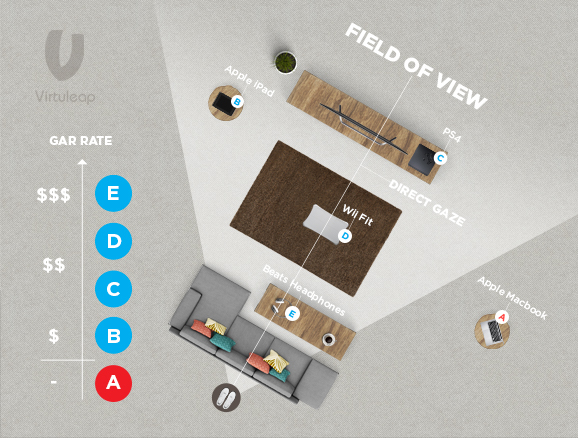Last week, the EUVR, the nonprofit organization dedicated to maturing the VR industry in Europe, officially backed the Gaze-At-Ratio (GAR) as the standardized ad tracking metric for the European VR community. The GAR algorithm determines the value of a user’s gaze to a digital ad in an immersive setting by factoring in the relative distance, duration, and depth of a user’s orientation to an ad-object as it enters and exits their field of view.
As the authors who introduced the GAR last month as our open-source approach to establishing a VR ad metric that is fueled by user attention, we are now developing it side-by-side with the community to help standardize a single metric that will be made available to everyone, who can follow our approach as we spearhead the effort, or adjust it to suit their needs.
Either way, the hope is that it evolves into an established best practice that will help to stabilize the ecosystem. “Any solution that helps to accelerate VR monetization is welcomed by everyone, and in Europe, standardization is extremely popular,” Juan Bossicard, co-founder of the EUVR, told me. “It’s the stepping stone to fostering a sustainable ecosystem, and the time for it is now.”
The impulse for GAR
The conception and development of the GAR was inspired out of frustration in the VR creator community with the lack of progress in establishing monetization models that suit the emerging medium and allow the industry to scale.
As it currently stands, every content creator and publisher is acting as a lone wolf that approaches the problem in their own unique or altogether different way each time. The lack of solidarity is stalling the industry by making both publishers and prospective advertisers reluctant to fully step into the space until the landscape matures.
“That gives off the impression of an as of yet premature market that doesn’t have the right essential benchmarks to be able to scale.” Ian Dolan told us, Head of Strategy & Content at PHD Worldwide, a global media agency that has opted to participate for GAR-enabled pilot campaigns running early next year.
The natural authority to turn to would typically be the IAB, which last July released their new ad unit portfolio that includes emerging formats like VR objects and 360 photos and videos, but their rollout only goes as far as outlining the format guidelines and doesn’t offer any indication on what new methods, metrics, or mechanisms can be used to calculate and determine the value of those immersive ad formats.
Holding attention, not receiving a glance
Any traditional digital method for calculating that value, like cost per impression, is obsolete and can’t be copied and pasted into an immersive setting. The new paradigm is in fact inviting advertisers to shift their perspective on digital advertising, which is otherwise thought of purely in quantitative terms, like ‘how many eye balls can we tag as having glanced our way?’ versus the more qualitative approach of ‘how much attention can we draw out of a single individual?’.

Above: Gaze-At-Ratio Illustration
This demo shows the GAR metric in action with 5 ad-objects scattered throughout a WebVR environment. The GAR rate accelerates as a user approaches the object, when it enters user’s line of sight or ‘direct gaze’, and whether the user interacts with the object, like picking up a soda can. The game plan is to expand the scope of the algorithm to incorporate key tech like eye tracking and haptic as they continue to advance.
The idea is to start with a user’s field of view and let their attention drive how we value everything in an immersive setting. The objects in the space are either absorbing a user’s attention, or they’re not, and the GAR algorithm can calculate all of that with unprecedented precision and determine a value that delights advertisers and offers creators an actual living.
Early next year, EUVR’s members will be the first to receive the official guidelines and workflows on embedding GAR into their content and platforms, along with a series of demo content, webinars, and support in transitioning VR companies to the GAR standard. The VR metric will also be introduced at Stereopsia next month in Brussels.
Amir-Esmaeil Bozorgzadeh, Thomas Balouet, and Hossein Jalali are cofounders at Virtuleap, a sandbox for creative developers to showcase their WebVR concepts to the world, which recently ran the world’s biggest WebVR Hackathon.

